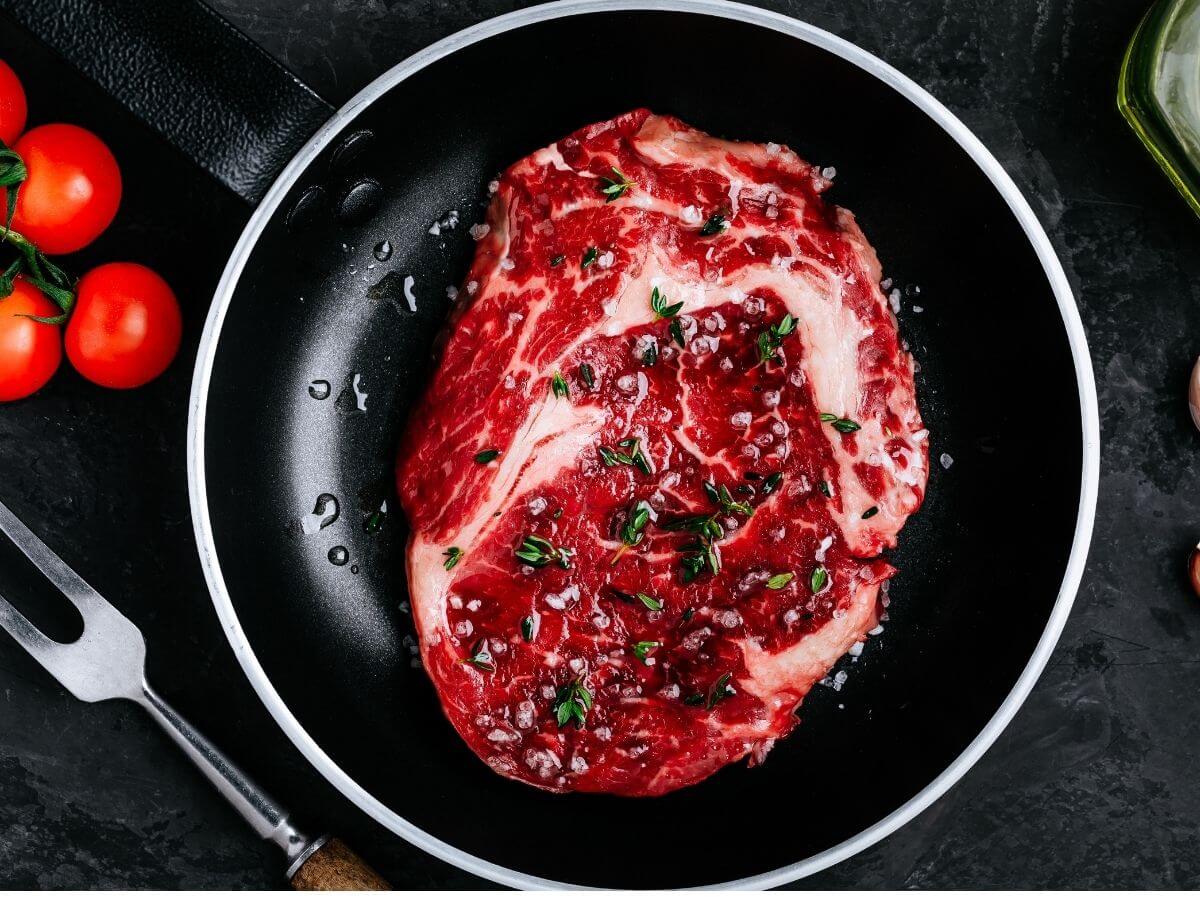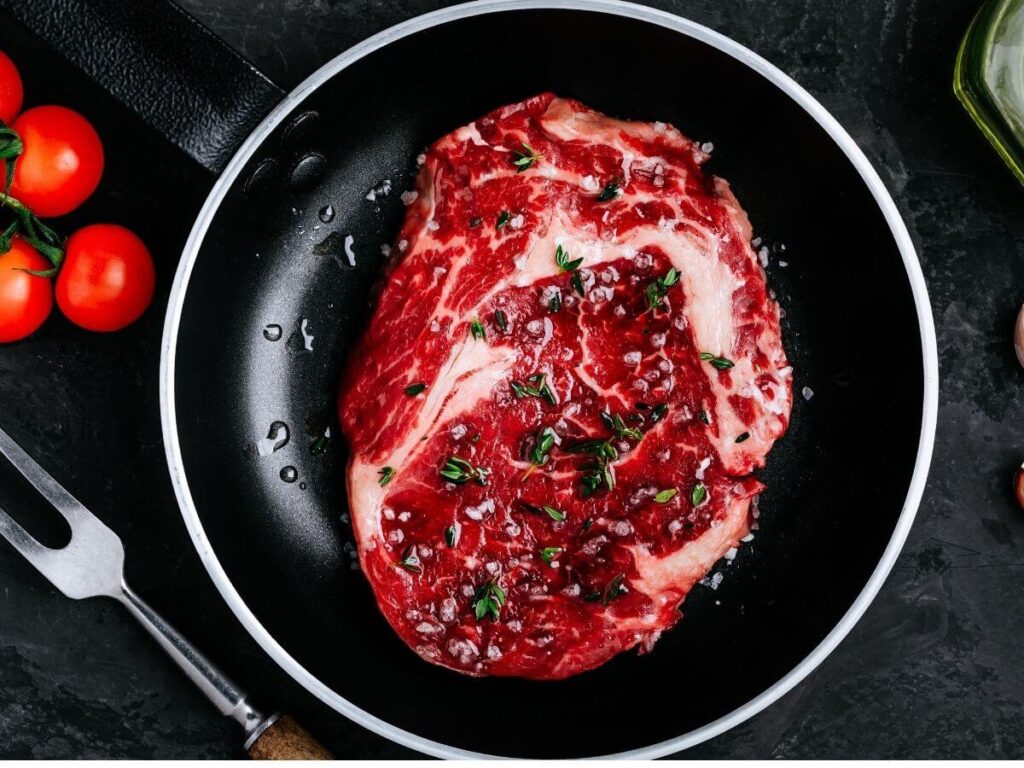If you like steak, and I mean really good steak, I can’t tell you how much my family enjoys this pan-fried ribeye steak recipe! These steaks make us feel like we’re having a luxury supper at one of the best steakhouses in town. But here’s the thing: These frying pan ribeye steaks are quick and easy to prepare, with only a few steps that guarantee a delicious steak every time! Keep reading to learn how to cook a ribeye steak in a frying pan.
You can’t quite appreciate the elegance of this dish until you try it in your own kitchen. For this demonstration, I’m using ribeye steak. If you prefer, you can substitute other steak cuts. Ribeye is excellent – it’s tender, tasty, and very well, and it has these wonderful fatty edges that taste like candy to me when well-browned.
The outcome of this fast cooking demonstration is a confirmed, tried, and tested rare steak that is so tender (no exaggeration) and juicy. Feel free to use your favorite steak sauce, or you may eat it plain because it’s already delicious. The basic flavor of this steak comes from salt and pepper. The addition of garlic, butter, and dried thyme leaves enhances the flavor and elevates it a notch or two above a standard steak. When you try it, you’ll understand what I mean.
How to Cook a Ribeye Steak in a Frying Pan
To cook a rib-eye steak, you’ll need the following handful of simple ingredients:
Ingredients:
- Olive Oil
- Ribeye steak
- Garlic Cloves
- Steak seasoning
- Butter – Use butter with high-fat content, like Irish or other European butter
- Fresh Herbs – Optional, rosemary and thyme are my first choice.
Direction:
- First, coat a medium to large frying pan with 1-2 tablespoons of olive oil.
- Heat the pan over medium-high heat, making sure it’s really hot before adding your steak(s).
- Meantime, coat both sides of your rib-eye steak with some olive oil (grapeseed oil also works), spreading the oil to coat all surfaces and edges evenly. Then, season the side facing up with steak seasoning mix.
- Place the seasoned side of the steak in the pan first, then season the other side. Next, move the steak just when you’re ready to flip it over to cook the other side.
- If your steak is approximately 1″ thick, cook it for 3-4 minutes on the first side; if it is about 2″ thick, cook it for about 5 minutes (for medium-rare).
- Cook for the same amount of time each time, depending on the thickness of the steak (3-4 minutes for a 1″ thick steak or 5 minutes for a 2″ thick steak). When the steak is done, the fat should be rendered, and the internal temperature should be around 135°F (57°C).
- Once you’ve rotated your steak(s), add the butter (along with the garlic and herbs) to the pan and let it melt before spooning it over the cooked side of the steak (basting or ‘arroser’) while you finish cooking.

Ingredients
Method
- First, coat a medium to a large frying pan with 1-2 tablespoons of olive oil.
- Heat the pan over medium-high heat, making sure it's really hot before adding your steak(s).
- Meantime, coat both sides of your rib-eye steak with some olive oil (grapeseed oil also works), spreading the oil to coat all surfaces and edges evenly. Then, season the side facing up with steak seasoning mix.
- Place the seasoned side of the steak in the pan first, then season the other side. Next, move the steak just when you're ready to flip it over to cook the other side.
- If your steak is approximately 1" thick, cook it for 3-4 minutes on the first side; if it is about 2" thick, cook it for about 5 minutes (for medium-rare).
- Cook for the same amount of time each time, depending on the thickness of the steak (3-4 minutes for a 1" thick steak, or 5 minutes for a 2" thick steak). When the steak is done, the fat should be rendered, and the internal temperature should be around 135°F (57°C).
- Once you've rotated your steak(s), add the butter (along with the garlic and herbs) to the pan and let it melt before spooning it over the cooked side of the steak (basting or 'arroser') while you finish cooking.
Yummy Sides
Here are some wonderful sides to pair your ribeye steak with:
- Bacon Jalapeno Twice Baked Potatoes
- Broccoli, sautéed
- Honey Garlic Roasted Carrots
- Rice with Turmeric
- Lemon Garlic Parmesan Orzo
Leftovers Storage Tips
While leftovers can be stored in an airtight container in the fridge for up to 4 days, it’s recommended only to make as much as you can eat right away.
If you have leftovers, try them cold – they’re delicious (kind of like thick, fatty slices of cold roast beef). If you must reheat the leftovers, do so gently in a covered microwave on 50% power.
How to Cook a Ribeye Steak in a Frying Pan Recipe Notes
I’ve compiled a list of some of my greatest tips for preparing the tastiest pan-seared ribeye steak.
Bring The Steak To Room Temperature
Allowing your steak to come to room temperature allows it to cook faster and avoids becoming fully raw on the interior. Even if you only do this for 30 minutes before cooking, you will have a wonderful even cook.
Do Not Season Too Early
Adding salt to your steak too soon will pull away moisture, so I recommend adding my steak seasoning literally right before you cook it.
The salt and seasoning should be applied to the steaks less than three minutes before cooking!
Use A Very Hot Pan
To get a superb seared steak, a very hot pan is required. How hot is it? Your oil in the pan should be just starting to smoke at this point. Use a high-smoke-point oil for best results. Olive oil works, and I usually use it, although light olive oil has a greater smoke point than extra virgin olive oil.
Use A Cast Iron Pan
The cast-iron skillet caramelizes the steaks more evenly, resulting in a more flavorful steak. However, that is a matter of personal preference, and any medium to a large skillet or frying pan would suffice.
Do Not Overcrowd
If you’re cooking more than one rib-eye at a time, make sure not to overcrowd your frying pan or skillet. If necessary, use multiple pans or cook your steaks in batches.
Large Your Steak
What exactly is “arroser”? A finishing method in French that translates as “to baste.” In the last 1 to 3 minutes of cooking, spoon the melted butter and fat drippings in the pan up and over the cooked steak. To enhance the flavor of the butter, garlic cloves and fresh herbs such as rosemary or thyme are sometimes added.
Using this basic approach will radically transform your cooking on practically any steak grilled in a skillet. It keeps your steaks soft and juicy while also assisting with even cooking.
If you’ve ever watched Gordon Ramsay cook a pan-seared steak, you’ve seen him and his team of chefs or chef candidates use this melange.




